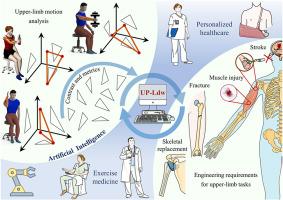基于上肢指标的个性化医疗保健和运动康复
IF 8
2区 计算机科学
Q1 AUTOMATION & CONTROL SYSTEMS
Engineering Applications of Artificial Intelligence
Pub Date : 2025-03-28
DOI:10.1016/j.engappai.2025.110673
引用次数: 0
摘要
快速准确的上肢运动分析和指标是增强运动医学知识图谱、推动个体化医疗的必要条件。然而,目前的研究在多时间尺度和多靶点的理解上存在局限性,并且存在生理结构上的差异。本研究提出了上肢动态翘曲(UP-Ldw)方法,该方法能有效地响应运动差异并适应生理特征。UP-Ldw通过参数化特征并结合生理结构参数来构建几何模型,以适应个体差异。动态时间正则化集成,以适应跨多个时间尺度的运动序列。最后输出各目标之间的运动相似度,便于比较和度量。此外,还开发了两个数据集:上肢三维数据集(UP-L-3D)和上肢几何建模数据集(UP-L-GM),用于验证。对比实验采用卷积神经网络(CNN)、主成分分析(PCA)和随机森林。结果表明,以指标20为判别标准,UP-Ldw的准确率最高,达到97.92%,运行时间较短,为1 ~ 8 ms。UP-Ldw与CNN混淆矩阵和PCA降尺度对齐,验证了其精确的运动分析。随机森林模型的平均准确率为91.1%,证实了几何模型的有效性。利用公开数据集Arm-CODA进行了泛化实验,进一步验证了UP-Ldw对生理结构的适应能力和上肢运动的有效度量能力。总的来说,UP-Ldw采用人工智能来衡量运动,促进镜像康复。这一进步为个性化医疗保健和运动康复的工程应用做出了重大贡献。本文章由计算机程序翻译,如有差异,请以英文原文为准。

Personalised healthcare and exercise rehabilitation based on upper-limb metrics
Rapid and accurate upper-limb motion analysis and metrics are essential for enhancing exercise medicine knowledge graph to drive personalised medicine. However, current studies face limitations in understanding multi-timescale and multi-target, compounded by discrepancies in physiological structure. This study proposes Upper-Limb Dynamic Warping (UP-Ldw), which effectively responds to motion discrepancies and adapts to the physiological characteristics. UP-Ldw constructs a geometric model by parameterizing features and incorporating physiological structure parameters to accommodate individual variations. Dynamic temporal regularization is integrated to accommodate motion sequences across multiple time scales. Ultimately, the motion similarity among various targets is outputted to facilitate comparison and metrics. Furthermore, two datasets are developed: Upper-Limb 3-Dimensional Dataset (UP-L-3D), and Upper-Limb Geometric Modeling Dataset (UP-L-GM), both utilized for validation. Comparison experiments employed convolutional neural network (CNN), principal component analysis (PCA), and random forests. Results demonstrate that UP-Ldw achieves the highest accuracy of 97.92 % using metrics 20 as the discriminant criterion, with a short running time of 1–8 ms. UP-Ldw aligned with CNN confusion matrices and the PCA downscaling, validating its precise motion analysis. The Random Forest model attained an average accuracy of 91.1 %, confirming the validity of the geometric model. A generalization experiment was conducted using the public dataset Arm-CODA, further validating UP-Ldw's ability to adapt to physiological structures and effectively metricize upper-limb motion. Overall, UP-Ldw employs artificial intelligence to metricize motion, facilitating mirror rehabilitation. This advancement contributes significantly to the engineering applications of personalised healthcare and exercise rehabilitation.
求助全文
通过发布文献求助,成功后即可免费获取论文全文。
去求助
来源期刊

Engineering Applications of Artificial Intelligence
工程技术-工程:电子与电气
CiteScore
9.60
自引率
10.00%
发文量
505
审稿时长
68 days
期刊介绍:
Artificial Intelligence (AI) is pivotal in driving the fourth industrial revolution, witnessing remarkable advancements across various machine learning methodologies. AI techniques have become indispensable tools for practicing engineers, enabling them to tackle previously insurmountable challenges. Engineering Applications of Artificial Intelligence serves as a global platform for the swift dissemination of research elucidating the practical application of AI methods across all engineering disciplines. Submitted papers are expected to present novel aspects of AI utilized in real-world engineering applications, validated using publicly available datasets to ensure the replicability of research outcomes. Join us in exploring the transformative potential of AI in engineering.
 求助内容:
求助内容: 应助结果提醒方式:
应助结果提醒方式:


